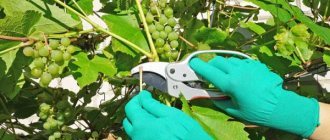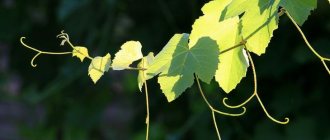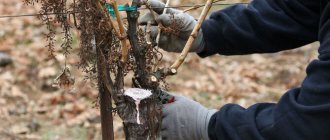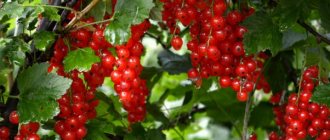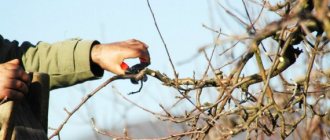Pruning usually becomes a problem for beginning winegrowers, since there are many nuances that need to be known in this area. You will have to decide on your own which shoots to remove and which to keep, so that the bush develops well and bears fruit. That is why it is necessary to know the structure of the bush, the principle of pruning young and mature grapes, and methods of tying to supports. Pruning grapes in the fall is important because diseased shoots are removed, a bush is formed, and the correct relationship between the above-ground and underground parts of the plants is established.
Why do you need to prune grapes?
To get a decent harvest, you need to learn how to regulate the growth of shoots. The vine develops quickly; in a season it can grow up to 2 m in length. If you don't shape the vine, the vine will become very intertwined within a couple of years. Up to 20 buds are formed on a long branch, from which fresh shoots appear.
During pruning of the vine, the grape bush is rejuvenated. By cutting out non-bearing or diseased shoots, the growth of new shoots on which grape clusters are formed is stimulated. Proper pruning improves the plant's immunity and makes the bush more tidy. This makes caring for the plant easier; each branch is well illuminated by the sun and ventilated.
If you do not prune the vine, it will quickly become intertwined and turn into an impenetrable jungle. The shoots on the vine will become thin and brittle, the berries on the grape clusters will become smaller, and the taste of the berries will become more sour.
What is a substitution knot
Knot replacement is part of the old European pruning system, discovered and popularized by French scientist and winegrower Jules Guyot in the mid-19th century. This pruning system is almost never found anywhere, but its essence is that just below the fruit shoot a branch is also left on which replacement shoots will grow.
In autumn, the entire fruit part is cut off to the knot. And the two vines of the twig again turn into an arrow and a twig.
The purpose of a knot replacement is to guarantee strong and well-ripened vines for fruiting and replacement next year.
Disadvantage: at least two extra idle shoots.
Structure of a grapevine
To understand the process of pruning a grapevine, you need to remember the terms of the names of the vegetative parts of the grapes.
- Head. The part of the bush from which grape sleeves (shoulders) develop.
- Grape sleeve (shoulders). This is an old perennial branch, it is easy to identify by its appearance - it has dense dark bark and is much thicker than the others. From the eyes left on this branch, young shoots grow, which are to be formed every year.
- Fruit arrow. This is an annual grape shoot on which there are several buds (or eyes). The number of buds on a branch is no more than 10, and it is from them that shoots with grape bunches grow. After the harvest is harvested, the fruit shoot with new shoots is completely cut out.
- Substitution knot. This is an annual branch with a small number of eyes (no more than 4-5 pieces), which is left as a replacement after cutting out the fruit shoot. Two replacement shoots are grown from this branch. The next year, new fruit shoots with grape clusters grow on it.
- Stepson. A second-order shoot develops from the leaf axil and must be cut out.
- Fruit link. This is the part of the bush that consists of a sleeve (perennial branch) and grown new branches. From these annual vines green replacement shoots grow, on which clusters of grapes form. In autumn, the shoots ripen and become replacement knots, from which new fruit links are formed.
How to prune grapes in summer
Summer pruning of grapes involves several simple procedures. The first of them is stepsoning . Second-order shoots are called stepchildren. They grow from summer buds in the leaf axils throughout the growing season. Stepchildren weaken the bush, taking nutrients and shading the ovaries. Experienced winegrowers recommend letting the shoot grow a little and then cutting it off, leaving 1-2 lower leaves on each shoot.
Cropped stepsons should not be left on the ground. This can contribute to the spread of diseases.
Pruning grapes in August involves so-called chasing . Its goal is to redirect nutrients to give the bush more strength to ripen the grapes. When the “crowns” of the shoots bloom, the vines stop growing, which means it’s time to mint the bushes. The tops of the shoots are pinched (broken off) by 15-20 cm.
Minting is not carried out on bushes damaged by disease, as well as in areas with close groundwater. Dry hot weather is another contraindication for minting grapes.
Among other things, bushes need to be thinned out . To do this, after flowering, you need to trim the grape leaves at the bottom of the shoots on which the clusters grow (5-10 leaves per shoot). The heroes of the following video talk in detail and clearly about summer “green operations”:
Timing for pruning grapes
The timing of pruning grapes depends on the weather conditions and climate of the region. After pruning the grapes, we must not allow the branches to be “caught” by frost. The optimal air temperature after pruning should not fall below +5 degrees. In the northern regions, in Siberia, the Urals and the Far East, spring pruning is carried out much earlier than in the south, where winter comes much later.
Autumn pruning of grapes begins 2 weeks before the first frost. The process of photosynthesis in grape shoots occurs until the plant goes into hibernation. This occurs 2-3 weeks after leaf fall, so completely fallen leaves are a signal for the beginning of autumn pruning of grapes.
Pruning in cold regions differs not only in timing from pruning in the south. In the warm climate of the country, the grape branches have time to become woody and ripen, so they winter well without shelter. In cold regions, it is recommended to radically prune the shoots so that in the short summer the vine has time to gain strength and overwinter under cover. The optimal timing of spring and autumn pruning by region is presented in the table:
| Region name | Spring pruning dates | Timing for pruning in autumn |
| Southern regions of the country, Crimean Peninsula | March 1-15 | November 15-30 |
| Volga-Vyatka region | March 15-30 | October 15-30 |
| Central Black Earth | March 15-30 | October 15-30 |
| Ural region, Siberia | March 15-30 | October 10-20 |
| Far Eastern region | April 1-15 | October 1-10 |
| North-Western region, Leningrad region | April 1-15 | October 10-20 |
| Kaliningrad region | March 15-30 | November 10-20 |
| Northern region (Karelia, Komi Republic) | April 15-30 | October 1-10 |
Bush rejuvenation
Over the years, the perennial parts of the crown of the bush - sleeves, shoulders, trunks and horns - lengthen, become covered with a large number of wounds and age. All this leads to weakening of shoot growth and fruiting of the bush and even the death of individual parts. At the base and on perennial wood, especially near wounds, dormant buds and shoots begin to intensively develop. Such bushes must be completely replaced or the outdated part of the crown must be rejuvenated.
To rejuvenate the sleeve, trunk and other perennial parts of the crown of the bush, when green shoots are broken off, one shoot is left, located closer to the base of the part to be rejuvenated. As the shoot grows, it is tied vertically to promote good development and ripening. In the second year, the shoots are cut to a restoration branch (stand), and only the best shoots are left on the sleeve for fruiting.
The outdated sleeve is removed no earlier than the second year of life of the restored knot, when its thickness becomes at least half the thickness of the rejuvenated part of the trunk or sleeve. When removing the part to be replaced, a stump of 2-3 cm is left above the knot, cleaning its upper cut with a garden knife. In order not to weaken the bush by causing large wounds, it is advisable to rejuvenate the sleeves gradually - no more than once a year.
Tips for Beginners
If you are a new wine grower, these general tips are for you.
1. When working with vines, you need to use gloves and garden tools that have been disinfected.
2. Don’t forget to leave 2-3 cm of shoot above the green bud.
3. The vine is cut down to a living layer of wood; when cut, it has a light green color.
4. Beginning winegrowers are advised to adhere to a simple rule during the formation of the vine. When pruning branches, the required number of eyes is left on each fruit arrow, adhering to the following parameters:
- shoot thickness 5 mm - 5-6 buds;
- shoot thickness 7-8 mm - 7-8 buds;
- shoot thickness 9-10 mm - 9-10 buds;
- shoot thickness 11-12 mm - 12-14 buds;
- shoot thickness 13-14 - 13-15 buds.
If the thickness of the branch exceeds the required diameter, the number of eyes is increased. This is due to the fact that on fattening shoots some of the eyes are blind, because the adult branch takes away the necessary nutrition for vegetative growth.
5. Cuts are made with a single movement of the pruning shears, without crushing the shoot bark. The cut should be smooth.
6. Pruning grapes forms the vine for 4-5 years; you should not wait for a harvest in the first years of growth.
How to prune young grapes correctly
Beginning gardeners are wondering how to properly prune young shoots of grapes in the first years of bush growth.
How to prune grapes after planting
At the very beginning of the “life path” of a grape bush, the main task of the gardener is to grow strong shoots. By autumn, the diameter of the branches should be on average at least 5-7 mm, so there is no need to prune the grapes in the first weeks after planting.
How to prune 1st year grapes
The first pruning of grapes is carried out in the summer. Around June, inspect the shoots and leave 1-2 of the strongest shoots out of 3-4. At the very beginning of autumn, you can carry out chasing so that the vines ripen better. In the fall, to prepare the bush for winter, you need to prune the first year grapes. To do this, measure 2-3 eyes from the soil level and cut the shoots above the bud.
Some gardeners do not prune first-year bushes in the fall, believing that it is better not to injure the plant before wintering. Should grapes be pruned in their first fall? The choice is yours.
How to prune 2nd year grapes
If you did not prune the young bush in the fall, do it in the spring of the second year before the growing season begins. You need to trim the grape vine so that there are 2 shoots left on the bush with 3-5 eyes on each (in the third spring, leave 4 shoots per bush).
Pruning of young grapes in the fall of the second year begins with the fact that 2 shoots that grew from the eyes left earlier are pruned into a replacement knot and a fruiting arrow. To do this, leave 2-3 eyes on the future replacement knot, and 6-10 on the fruit vine.
When the grapes begin to bear fruit, cut off the fruit vine completely in the fall, and the shoots that grew from the replacement knot will remain on the bush, which will bear fruit next year.
As you can see, pruning grape bushes is a serious matter, but not that difficult. Our tips and recommendations from the authors of the videos will help you at the beginning of your viticultural journey, and in the future you will gain experience and (we believe!) achieve success in gardening.
On the origin of the pruning scheme with a substitution knot
Those winegrowers who speak negatively about the formation of substitution with a knot are wrong, saying that this is the last century, and they have been doing this since the Soviet 50s. This pruning was proposed by Jules Guyot, a French doctor and physicist who was fond of growing grapes and winemaking. His book “Vine Culture and Vinification,” which outlines the still popular essence of pruning, was published in 1860. This means that opponents of this technology are mistaken by about a century.
Abstract diagram according to Guyot: in the center there is a fruit link (substitution knot plus fruit arrow); on the left is the same fruit link, but in the summer (the arrow was tilted, the replacement knot was at the bottom), on the right is the same vine in the fall, after pruning it will again become a fruit link, as in the center
Perhaps Guyot's formation is outdated; more progressive methods have appeared. They say that the Chablis scheme is popular in France today. Russian gardeners also began to practice it. But there is very little information about Chablis pruning; only professionals can understand it, think it through somewhere and apply it. For beginners, it is better to start with a scheme that has already been proven by everyone, about which there are many reviews, videos and recommendations. And when the basics are mastered, you can move on to more modern and fashionable ones. Personally, after reading many articles and watching videos on this topic, Guyot pruning still seems difficult. Perhaps the final understanding comes with practice, when I myself grow a fruit-bearing vineyard from my annual seedlings.
Video: fan formation without knot replacement, a variation of the Chablis method
Types and schemes for processing grape bushes
Any pruning represents a mechanical intervention in the plant’s body and inevitably leads to the appearance of wounds. In order to mitigate its consequences, you should adhere to simple rules developed by professionals. Firstly, no matter what tool the gardener uses, be it a knife, pruning shears or a hacksaw, it is important to ensure that it is sharp. This will minimize damage and will promote rapid healing of the plant, since the risk of diseases on the smooth surface of the wound is significantly lower. Secondly, in order for the damaged areas to remain smooth after using pruning shears, you need to place the blades on the side of the shoot that you plan to save, focusing on the part to be removed.
Seasonal pruning can be carried out as a rejuvenating procedure for the plant, in order to maintain its shape or to form the basis of a young bush. Based on this, there are 3 types of pruning:
- forming - applied to plants aged from one to 4 years; during its implementation, all shoots and branches that are not included in the contours of the desired shape of the future bush are removed;
- annual pruning, carried out in spring or autumn to maintain the health and decorative appearance of grape bushes;
- rejuvenating - pruning during which old dry branches are removed, making room for fresh shoots.
In addition, there are 3 types of pruning depending on the length of shortening the elements of the bush:
- short pruning, during which the vine is shortened by 2-4 eyes, is usually used on young bushes;
- medium, reducing the length of the vine by 5-10 buds;
- long, shortening a branch or shoot by more than 10 buds.
The shape of a grape bush can be fan-shaped or standard; its choice depends mainly on the climate. An adult standard-shaped bush has an above-ground part 40-80 cm high, which is only possible in the southern regions, where there is no need to cover the plants for the winter. The fan bush is compact and can be easily covered during cold weather; its sleeves grow gradually, from year to year.
Spring pruning of damaged bushes
If the grapes are frozen over the winter, there is a good chance of restoring the plant. At least partially. Let's consider a method of restorative pruning after various damages.
The bushes are frozen
First, check the condition of the kidneys by making incisions on them:
- green color indicates kidney health;
- black and dark brown - about damage.
The cuts are made moving from the base to the top of the branch. By counting the dead eyes, the amount of damage is calculated. Depending on the damage, take the following actions:
- If the death rate was less than 80%, leave more buds during formation than provided for in the scheme. An additional harvest is obtained thanks to shoots on fruit-bearing branches left during autumn pruning.
- If more than 80% have died, sanitary pruning is needed in two stages. Before the buds open, remove frozen branches and damaged supporting sleeves. When greenery appears, sanitary pruning is completed by removing excess growth.
- If the damage is 100%, the stepsons are checked - being more frost-resistant, they more often survive the winter. If the buds on the stepsons have also died, you can form fruit-bearing links from young shoots or fattening shoots growing from buds on perennial branches.
Frostbite of the root system
In frosty winters with little snow, part of the grape root system is damaged or dies. Necessary actions:
- They dig up the ground at the will of the bush.
- Root cuts are made. The sections of undamaged roots are white, while those of frostbitten roots are dark brown. If the frostbite diameter of the roots is up to 2.5 mm, the vine will recover next year. The main task of the gardener is to reduce the load on the root system by cutting off the fruiting branches short.
Spring hail
If there was hail in the spring and the bushes lost a lot of foliage, young shoots are pruned to 1-2 buds. Then shoots will appear, which are thinned out - this is done to activate the reserve buds, which will bear fruit the next year.
Cold snap
Frosts often occur in the spring just as the buds are opening. They can not only destroy new buds and shoots, but also a one-year-old vine. Further actions depend on the degree of damage caused:
- The vine is damaged. It is recommended to cut last year's branches short to stimulate the growth of other shoots - then the dormant buds will awaken.
- If frosts have damaged the green part and flowers, to awaken dormant buds you need to shorten the annual shoots - this will help partially restore the harvest.
- If the tops of the branches are damaged, as well as a small part of the leaves and inflorescences, you can do without special pruning.
Assessment of bush health - damage categories
First of all, it is important to inspect the grape bushes and assess their health, because the pruning scheme will largely depend on this. There are four degrees of damage:
- the first degree is characterized by the death of more than a third of the buds, while in order to obtain a harvest it is necessary to strengthen the fruit links: 15-18 eyes are left on each vine, additional shoots are removed for the speedy restoration of the plant;
- in the second degree, the damage reaches 80%, the main goal in this case is to save the grapes and obtain the possible number of fruits - all old and additional shoots are pruned, and the remaining ones needed to restore the bush are pruned to 15 buds;
- the third degree is expressed by the death of all buds and partial damage to the plant tissue: all that can be done is pruning the shoots into 2 buds and re-forming the development of the bush;
- the last degree is the complete death of the above-ground part of the plant; in this case, you can only try to restore the roots with the help of grafting.
The choice of measures for its restoration and preservation depends on the correct determination of the category of grape damage. If the bush freezes slightly, this indicates that it is necessary to improve its shelter during the winter.
